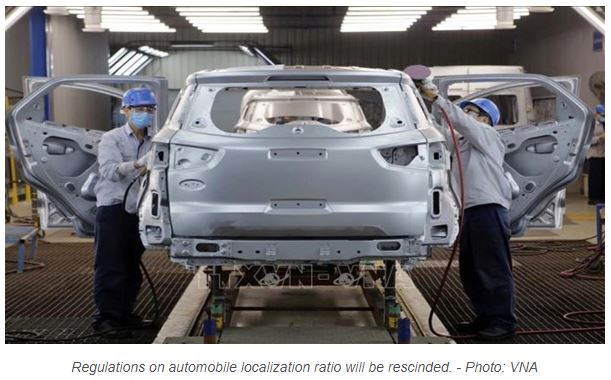Vietnam: Regulations on auto localization ratio to be rescinded
The regulations on the automobile localization ratio will be abolished on October 10, after they have been in force for almost 20 years.
On August 12, the Ministry of Science and Technology enacted a circular to rescind the regulations on calculating methods of the automobile localization ratio, including Decision No. 28/2004, Decision No. 05/ 2005 and Circular 05/2012. The circular takes effect from October 1, 2022.
According to the Vietnam Association of Mechanical Industry (VAMI), the regulations related to the automobile localization ratio are no longer suitable for the current situation and should be abolished to encourage competitiveness among domestic enterprises.
The removal of those regulations would help improve the investment environment and allow domestic automobile manufacturers to maintain production in competition with completely-built-up (CBU) cars imported from ASEAN countries with a tax rate of 0% from 2018.
Automotive expert Nguyen Minh Dong said that it was really difficult to produce high-quality automobiles with the current localization ratio regulations. Some important parts of the cars were underestimated, while others were highly valued. The adjustment to the auto localization rate calculations will create driving forces for the manufacturers to improve their product quality with the most advanced technology.
Moreover, the features and auto parts have become increasingly innovative and modern, accounting for a large proportion of the overall value of the vehicle. For instance, car body frames are more complex than those for buses.
The localization rate of passenger cars in Vietnam is still quite low due to the slow development of auto parts and accessories suppliers, in terms of both quantity and quality. Only a few domestic suppliers can get involved in the supply chains of automobile manufacturers in Vietnam.
The number of auto parts suppliers in Vietnam is far lower than that in Thailand. According to the Ministry of Industry and Trade, Thailand has nearly 700 tier-1 part suppliers, while Vietnam has less than 100. In addition, Thailand has some 1,700 suppliers of Tier 2 and 3 and Vietnam has less than 150.
It results in a low localization rate of passenger cars of less than nine seats. The auto localization rate in Vietnam has reached around 7-10% so far, much lower than the target and the figures of other neighboring countries such as Thailand, Indonesia and Malaysia.
According to the Ministry of Industry and Trade, the average output growth of the auto industry is much lower than that of the whole industry.
Vietnamese enterprises have been left behind in the race for high-quality auto parts and accessories due to their low speed of technological innovation. Many auto parts suppliers still have little capability and production technology to get involved in the value chains of the domestic automotive industry.
Over the past 10 years, Vietnam has signed a series of free trade agreements (FTAs) such as the ASEAN Trade in Goods Agreement, the Comprehensive and Progressive Agreement for Trans-Pacific Partnership, and the EU–Vietnam Free Trade Agreement.
These agreements require member states to commit to the removal of tariff barriers for imported cars and auto parts.
Source: SGT


 Thailand
Thailand




